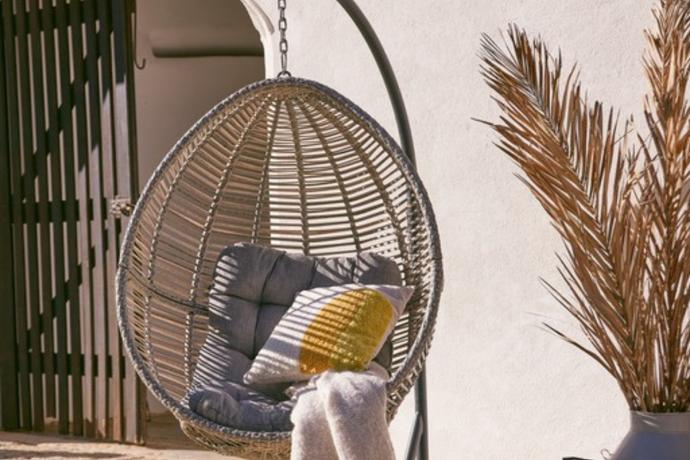- No products in the cart.
CURL UP IN STYLE: WHY EGG CHAIRS ARE THE ULTIMATE SEATING CHOICE FOR MODERN COMFORT
29
Jun
There’s something undeniably inviting about a chair that seems to hug you. In the world of interior design, few seating options are as instantly recognizable and adored as the egg chair. With its cocoon-like structure, sculptural design, and unmatched comfort, the egg chair has become a go-to choice for homeowners, interior designers, and design enthusiasts alike. Whether nestled in a quiet reading corner, placed by a sunlit window, or used as a statement piece in a modern lounge, egg chairs offer both form and function in one stunning package.
As trends come and go, some furniture styles manage to transcend decades—and egg chairs are among them. They effortlessly blend retro charm with contemporary appeal, making them suitable for a wide range of spaces. But what exactly makes these chairs so popular? What are the different types available? And how can you choose the right one for your home?
In this comprehensive guide, we’ll explore everything you need to know about egg chairs—from their history and types to where to use them and how to care for them. Whether you’re a curious buyer or a design aficionado, this guide is your one-stop source for all things egg chair.
What Is an Egg Chair?
An egg chair is a type of lounge chair characterized by its curved, enveloping design that resembles the shape of an egg. The seat usually features high sides and a rounded back that wraps around to create a semi-private, cozy sitting experience. This distinct shape not only provides visual interest but also offers exceptional comfort and support.
Unlike traditional chairs with flat or angular backs, the egg chair cradles the body, making it a favorite for relaxation, reading, and even working from home. Some versions come with a swivel base, while others are designed to hang from a stand or ceiling, adding an element of gentle motion to your lounging experience.
Egg chairs come in a variety of styles, materials, and sizes, making them suitable for both indoor and outdoor use. While their aesthetic appeal is obvious, their ergonomic benefits are just as important. The chair’s wraparound design can offer excellent lumbar support and a sense of seclusion, which is perfect in today’s fast-paced world where personal downtime is a luxury.
The History and Evolution of Egg Chairs
The concept of the egg chair dates back to the mid-20th century, a time when modernist design was flourishing. The original egg chair was designed in 1958 by Arne Jacobsen, a Danish architect and designer known for his pioneering contributions to Scandinavian design. Commissioned for the SAS Royal Hotel in Copenhagen, the chair was intended to provide both privacy and style in the hotel’s busy lounge areas.
Jacobsen’s design was groundbreaking. It combined fiberglass with foam padding and fabric upholstery, supported by a swiveling aluminum base. The chair’s sculptural form stood in contrast to the more rigid and formal furniture of the era, offering a relaxed and futuristic alternative that caught the world’s attention.
Over the decades, the egg chair has been reinterpreted by countless designers and manufacturers. Variants emerged with different materials, sizes, and shapes, but all retained the signature cocoon-like silhouette. Hanging egg chairs, outdoor versions made from rattan or wicker, and padded indoor models became widespread.
Today, the egg chair continues to be an iconic piece of furniture that bridges the gap between comfort and avant-garde design. Its evolution reflects broader trends in lifestyle and décor—from the minimalist interiors of the 1960s to today’s eclectic, personality-driven homes.
Types of Egg Chairs
Egg chairs are not one-size-fits-all. Depending on your space, lifestyle, and design taste, there are several types to choose from:
1. Classic Upholstered Egg Chairs
These follow the traditional mold of the original egg chair, usually made with a fiberglass shell and upholstered in fabric, leather, or velvet. They often include a swivel base and are best suited for indoor use in living rooms, reading nooks, or offices.
2. Hanging Egg Chairs
These are suspended from a ceiling or freestanding metal frame. Made from materials like wicker, rattan, or synthetic resin, hanging egg chairs are great for both indoor and outdoor spaces. They offer a gentle swinging motion and are perfect for creating a relaxed, bohemian vibe.
3. Outdoor Egg Chairs
Designed to withstand the elements, these chairs typically feature water-resistant cushions and durable frames made from rattan or powder-coated steel. They’re ideal for patios, balconies, gardens, or poolside lounging.
4. Double Egg Chairs
Built to seat two, double egg chairs are wider and often come with thicker cushions. These are ideal for couples or for creating a cozy, oversized lounging space.
5. Modern Minimalist Egg Chairs
These reinterpret the original design with cleaner lines, sleeker silhouettes, and minimalist features. They often come in neutral tones and are perfect for contemporary interiors.
Each type offers its own unique benefits and aesthetic appeal, allowing you to pick one that fits seamlessly into your home and lifestyle.
Materials and Construction
The material and build of an egg chair greatly impact its comfort, longevity, and appearance. Here's what to look for:
Frame
-
Fiberglass or Molded Plastic: Often used for traditional indoor egg chairs due to its strength and shape-retention.
-
Metal (usually aluminum or steel): Used for swivel bases or hanging chair supports.
-
Wicker or Rattan: Common for hanging or outdoor egg chairs; provides a natural, relaxed look.
Upholstery
-
Fabric: Offers breathability and softness. Linen, cotton, or polyester blends are common.
-
Velvet: Adds a touch of luxury with a soft texture and vibrant color.
-
Leather or Faux Leather: Durable and easy to clean, ideal for a more masculine or executive vibe.
Cushioning
-
Foam Padding: Provides support and comfort; high-density foam is better for long-term use.
-
Water-Resistant Foam: Used in outdoor cushions to prevent mildew and wear.
Understanding these materials helps you choose an egg chair that matches both your design preferences and functional needs.
Benefits of Egg Chairs
Why choose an egg chair over a conventional armchair or recliner? Here are some compelling reasons:
1. Comfort and Ergonomics
The enveloping shape of the egg chair conforms to the natural curve of the human body, offering superior back and neck support. It creates a private nook for reading, relaxing, or daydreaming.
2. Versatile Design
Egg chairs are as functional as they are decorative. They complement a range of interior styles, from Scandinavian minimalism to boho chic.
3. Statement Piece
Few furniture items draw attention like an egg chair. Its sculptural form instantly becomes a focal point in any room, elevating the entire aesthetic.
4. Mood Enhancer
Whether you're curling up with a book or sipping tea on your balcony, egg chairs encourage mindfulness and relaxation. They provide a retreat from the chaos of daily life.
5. Indoor and Outdoor Usability
With both indoor and weather-resistant options available, you can enjoy the comfort of egg chairs anywhere—from your living room to your garden.
These benefits make egg chairs an investment in both comfort and style.
Where to Use Egg Chairs
One of the best things about egg chairs is their versatility. Here's where you can make the most of them:
Living Room
Position one by a large window or beside your coffee table to create a cozy reading nook or conversation corner.
Bedroom
Egg chairs in the bedroom can be a stylish alternative to a traditional chaise lounge. They’re ideal for winding down with a book or enjoying your morning coffee.
Home Office
Need a break from your desk? An egg chair offers a perfect spot for thinking, brainstorming, or taking a well-deserved pause.
Patio or Balcony
Outdoor egg chairs transform these areas into mini-retreats. Pair them with string lights and a side table for a dreamy evening setup.
Nursery
A plush egg chair can double as a nursing chair, offering comfort and support for new parents during feeding or lullaby time.
Wherever you place one, an egg chair instantly makes the space more welcoming and relaxing.
Styling Tips for Egg Chairs
Egg chairs are eye-catching by design, but with a few styling tricks, you can make them even more impactful:
Use a Throw Blanket
Drape a textured throw over the side to add warmth and a touch of softness.
Add Cushions
One or two accent pillows can enhance comfort and tie the chair into your room’s color scheme.
Pair with a Rug
A rug beneath your egg chair can ground the space and define the seating area. Choose a shape that complements the chair’s curves.
Position Thoughtfully
Egg chairs have a strong presence, so give them breathing room. Avoid cramming them into tight corners or cluttered spaces.
Consider Lighting
Place a floor lamp or pendant light nearby to highlight the chair and create a cozy reading environment.
Small details go a long way in turning your egg chair into a well-loved, well-used feature of your home.
Buying Guide: How to Choose the Right Egg Chair
Not sure where to begin when shopping for egg chairs? Here are a few things to keep in mind:
Consider the Space
Measure your space before choosing. Make sure the chair fits comfortably without crowding the room.
Decide on Purpose
Are you looking for a statement piece, a relaxing reading nook, or outdoor seating? Your purpose will determine the best type and material.
Check Weight Limits
Especially for hanging or double egg chairs, always verify the weight capacity for safety and longevity.
Evaluate Maintenance Needs
If you want low maintenance, opt for easy-to-clean fabrics or water-resistant materials for outdoor use.
Sit Test (if possible)
If buying in person, always sit in the chair. Comfort varies based on cushioning and design, so trust your body’s feedback.
By balancing these considerations, you’ll find an egg chair that offers style, support, and satisfaction for years to come.
Maintenance and Care
Proper care keeps your egg chair looking and feeling great:
For Indoor Chairs
-
Vacuum regularly to remove dust and pet hair.
-
Spot clean spills immediately using a mild detergent.
-
Avoid direct sunlight to prevent fading, especially with fabric or leather.
For Outdoor Chairs
-
Cover them when not in use to protect from sun and rain.
-
Clean cushions and frames with mild soap and water.
-
Store indoors during harsh weather seasons to prolong lifespan.
Regular upkeep will help you maintain the beauty and integrity of your chair, ensuring it remains a cherished part of your home.
Conclusion
Egg chairs have come a long way from their mid-century origins, evolving into one of the most versatile and beloved seating options on the market today. Their unique design, superior comfort, and ability to elevate any space make them more than just furniture—they’re an experience. Whether you’re adding one to your living room, your balcony, or even your nursery, egg chairs offer a perfect blend of style and function.
With so many types and materials to choose from, there’s an egg chair out there for everyone. And with proper care, these stunning pieces can remain timeless additions to your home for years. So go ahead—curl up, relax, and enjoy the embrace of an egg chair that suits your lifestyle perfectly.














